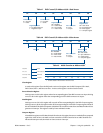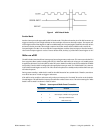
68 CMX158886 cpuModule BDM-610000049 Rev G
Legacy Mode and Native Mode IDE
The onboard EIDE controller may be configured as a either a Legacy or Native Mode IDE controller in the BIOS
Setup. However, the operating system must support the selected mode for the device to operate correctly. The
default configuration for the controller is Legacy Mode, as this is supported by most operating systems.
Legacy Mode
Legacy mode is the default configuration of the onboard EIDE controller. When in this mode, the controller will
be fixed to use two interrupts: IRQs 14 and 15. Similarly, the I/O address of the controller will be fixed in the
system. When in Legacy Mode, only a primary and secondary channel may be used in the system.
Native Mode
Native Mode allows more flexibility, as the system resources used by the IDE controller may be modified. When
in Native Mode, the IDE controller only requires a single IRQ. Unlike Legacy Mode, this IRQ may be changed by
the user or the operating system for better distribution of the system IRQs. When IRQs in the system are more
evenly distributed, interrupt latency is minimized. The base address of the controller may also be modified.
Configuring the ATA/IDE Disk Chip Socket
The cpuModule was designed to be used in embedded computing applications. In such environments, rotating
media like hard disks and floppy disks are not very desirable. It is possible to eliminate rotating storage devices
by placing your operating system and application software into the cpuModule's ATA/IDE Disk Chip socket.
Before installing a device in the ATA/IDE Disk Chip socket, it is highly recommend to first configure the secondary
IDE controller and device mode in the BIOS setup.
The secondary IDE controller must be enabled in the BIOS to allow read and write access to the device. When a
device is installed in the socket, it will always appear as a master on the cpuModule’s secondary IDE controller.
From the BIOS setup screen, the user can also configure whether the socket contains a DMA mode or PIO mode
device.
• DMA Mode: DMA mode will reduce CPU overhead.
• PIO Mode: When the socket is in PIO mode, PIO transfers are supported. PIO mode supports write
protection.
WARNING Before installing a device in the ATA/IDE Disk Chip socket, the system must be configured in
the correct mode. For details on configuring the socket, refer to Chapter 4, Using the cpuModule


















